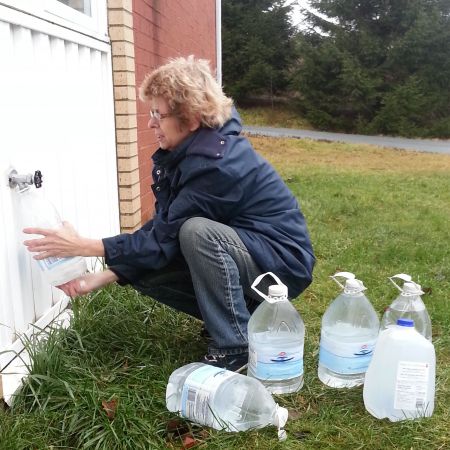K'JIPUKTUK, HALIFAX - When Melissa King bought her home on Old Sambro Road in 2010, a water test done by the former owners showed arsenic in her well–not an uncommon finding in Nova Scotia. King asked for an arsenic treatment system to be installed and then proceeded with the sale.
After she moved in, a neighbour passed her a copy of a letter addressed to the previous owners from the Nova Scotia Department of Environment. The July 2010 letter explained that her well had been tested regularly since 2003, and that not only arsenic, but lead and cadmium levels had exceeded Canadian Drinking Water Guidelines several times. And since 2003, uranium, boron and lead levels had all been increasing. The letter advised not to use water from her well for drinking, cooking, or brushing teeth.
King contacted a lawyer to discuss her options, but the previous owners had left the country.
Since she found out about the lead and other contaminants in her water, King showers at the gym and brings in water for drinking, cooking, and dishes. After her son was born last year, she started carrying a tub in her car trunk and bathed him when visiting friends and family. "I certainly wouldn't feel safe bathing him at home," says King. "Even with filtration in place."
Investigations by the Nova Scotia Department of Environment (NSE) linked the lead problem in King's well - and uranium problems in two other nearby wells - with the operation of a construction and demolition (C&D) waste recycling site about 400 metres away from King on Old Sambro Road. From 1998 until it closed in January 2013, RDM Recycling accepted debris from construction and demolition work in Nova Scotia, then sorted and processed it, sending anywhere from half to three quarters of it to be reused or recycled.
According to former RDM owner Michael Lawrence, much of the material that couldn't be recycled was ground up and sent to the Otter Lake Landfill. What didn't end up at Otter Lake remained on site at RDM. By 2004, there was 120,000 tonnes of waste C&D material piled on the site.
The Nova Scotia Department of Environment started paying attention to RDM around 2002, when a proposal to add a landfill to the site was approved by the city. (HRM Council approved the landfill against the recommendation of city staff, who expressed concern that the site was in an otherwise residential area.) The landfill needed NSE approval to go forward, so in the summer of 2003 the department commissioned water testing of some residential wells near the site. What they found were high levels of boron and sulphate in some wells downgrade from the RDM site, with the probability that run-off from the site was affecting surface and groundwater.
The department required RDM to clean up their site, and gave permission to build a single, clay-lined landfill cell to permanently store the 120,000 tonnes of un-recyclable debris on site. Around the same time, NSE declined the city council-approved proposal for RDM to become a working landfill for C&D waste.
By 2005, RDM had accumulated more un-recyclable waste on site. Area Councillor Stephen Adams, who had made the motion to approve RDM's landfill proposal against staff recommendation back in 2002, sent a letter to NSE requesting that the department grant the company permission to build another cell to store this new waste. HRM regulations for a C&D processing site like RDM require that no materials be stored on site for more than one year. NSE declined the new cell proposal.
Shortly after that in November 2005, RDM owners Michael Lawrence and Roy Brown got out of the C&D business, and leased the RDM site to a new company that had formed in 2003, run by Kurt Jacobs and Brian Dubblestyne. This new company, 3076525 Nova Scotia Limited, took over both the recycling operation and the name RDM Recycling. (Jacobs and Dubblestyne are also directors of Mirror Nova Scotia, operators of the Otter Lake Landfill, and Jacobs is president of Dexter Construction.)
Fast forward four years.
Marlene Brown, the neighbour that gave Melissa King that awkwardly-timed NSE letter warning her about her lead-contaminated well water, had also saved years of the quarterly water tests done at King's well. The results, when displayed in a spreadsheet form, show a steep rise in iron, lead, manganese, suspended particles, and colour starting in 2006.
"I noticed the fluctuation in my own water samples," says Brown, "and then I started going to my neighbours. We met up and sure enough, once all our water samples were put on spreadsheets, we could see what had been happening."
At the same time that Brown was becoming alarmed about water test results, RDM Recycling approached NSE about the possibility of reducing the frequency of water monitoring that had been ongoing since 2003. For six years, 7 domestic wells and at least 3 on-site wells had been tested quarterly, with another 7 domestic wells tested annually. But since 2005, no one at Nova Scotia Environment had paid much attention to the accumulating data.
“The results were just being filed away in cabinets,” says Brown.
In response to RDM's request to reduce the frequency of tests, NSE asked their hydrogeologist Melanie Haggart to analyze the data. She reported what appeared to be "a growing plume of impacted groundwater both on site and leaving the site toward the south." She also posited that this plume might be responsible for elevated uranium levels in area. "The uranium is most likely naturally present in solid form in bedrock, but is being dissolved due to changes in groundwater chemistry," she states in a February 2010 NSE memorandum.
In November 2010, NSE issued a Ministerial Order requiring that RDM Recycling do something to mitigate the effects to Melissa King's well and another two impacted by high uranium levels. The order also required continued monitoring of another 14 domestic wells in the area, and asked for a professional assessment of the site, including the delineation of a groundwater contaminant plume originating at RDM.
Current RDM Recycling directors Kurt Jacobs and Brian Dubblestyne appealed the Ministerial Order in December 2010 on grounds that Nova Scotia Environment was fully aware and approved of activities at the site, and that the interpretation of water tests did not take into account the existing geologic conditions of the area.
This fall, Marlene Brown and Melissa King were named intervenors in the case, with plans to deliver evidence about the impacts to local area domestic wells.
Despite the Ministerial Order, RDM Recycling operated as normal until January 2013. The city is responsible for regulating C&D processing facilities, but relies on Nova Scotia Environment to alert it to any non-compliance issues with the Environment Act.
In late 2010 when HRM Solid Waste's Shari Dillman enquired about compliance for four C&D sites, NSE district manager Stephen Westhaven wrote back stating that there was an open investigation at the RDM site, and "we are unable to discuss compliance at this time." HRM seems to have interpreted this as a go-ahead, and issued a license to RDM to operate in 2011. A year later they issued another license for 2012. Then in 2013, RDM was denied, based on the lack of compliance letter from NSE.
Requests for confirmation on the existence or contents of a 2011 compliance letter from NSE regarding RDM Recycling are outstanding. NS Environment spokesperson Lori Errington declined comment due to the ongoing court appeal. HRM's Shari Dillman confirms that the city “received correspondence from NSE” regarding the site’s compliance with the Environment Act, but that the contents of the letter itself are only available through a Freedom of Information Act request.
The appeal will be heard in court in late April 2014, and Marlene Brown is working to assemble evidence to present before that, with some help from the East Coast Environmental Law Association. In the meantime, "we're focussing on safe water," says Brown.
"Not everyone has water systems in this community," says Brown, "and some people's water systems are failing. It's so unpredictable. Water systems only take out certain things, and before you know it you have 4 machines side by side. It's very costly."
To help out, St. Paul's Church in Spryfield has offered free use of its outdoor tap to Harrietsfield residents with contaminated wells. And once the weather gets cold, they are inviting people inside to fill up containers.
If a site cleanup is not possible, Melissa King is also focussed on how to get clean water. "We would like to see city water," says King, though she would even be happy to have trucked in water. "The city does have a responsibility to us. We pay taxes, we live there. It is their waste at the end of the day that's contaminating our well."
FURTHER INFO:
Google Map showing RDM Recycling and houses included in water monitoring program.
WHO OWNS WHAT?
For years the RDM site was an auto salvage yard run by Ernest A. Nicholson. In 1997, Michael Lawrence and Roy Brown took over the site as RDM Recycling Limited, and started bringing in C&D waste for processing. In 2005, Lawrence and Brown leased the site to a new company run by Kurt Jacobs and Brian Dubblestyne, who took over the operation and the name RDM Recycling. Jacobs and Dubblestyne are also directors of Otter Lake Landfill operators Mirror Nova Scotia, and Jacobs is president of Dexter Construction.
Ernest A. Nicholson Limited, Lawrence and Brown are all named in the Ministerial Order along with both the new and old RDM Recycling.
WHAT’S IN THE MINISTERIAL ORDER?
A November 2010 order from the Nova Scotia Minister of Environment names past and current owners and operators of the RDM site. Here's a brief synopsis of what the order requires:
- Assess the site, including outlining the size and shape of a groundwater plume containing dissolved uranium, boron, calcium, sulphate, and elevated alkalinity, along with other contaminants. This would also include an assessment of the soil on site.
- Submit a plan to mitigate the effects of uranium in two domestic wells, and to mitigate the effects of lead in a third.
- Submit a groundwater monitoring plan to be approved by Nova Scotia Environment. In the meantime continue testing in all monitoring wells on site, as well as 17 domestic wells in the area. Testing frequency is to range from quarterly to annual. All are to be tested for general chemistry and metals; and some for volatile organic chemicals (VOCs), total petroleum hydrocarbons, and benzene, toluene, ethylene, and xylene (BTEX).
- Review the site drainage and surface water management, and revise if necessary. In particular, identify locations where draining surface water may come into contact with soluble C&D materials, and then penetrate to groundwater.
- Evaluate impact to nearby Shea's Lake, and continue water testing at four sites around the lake.
- Review leachate management activities and monitoring, and submit a revised plan to Nova Scotia Environment.
- Submit a Remedial Action Plan to address any identified impacts of the release of substance from the site.




